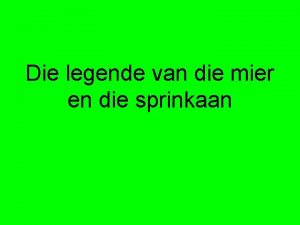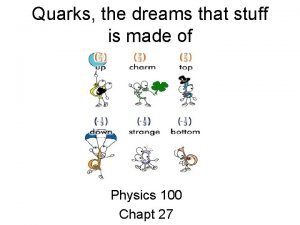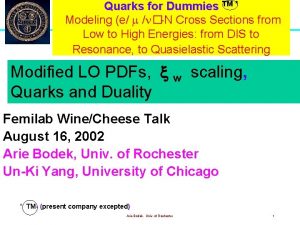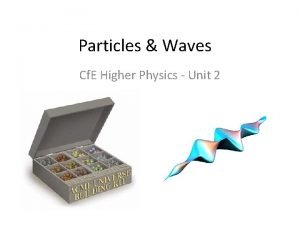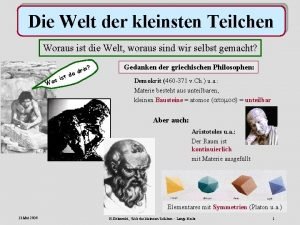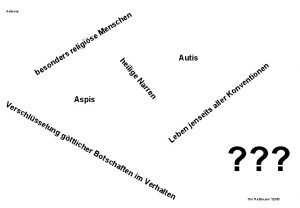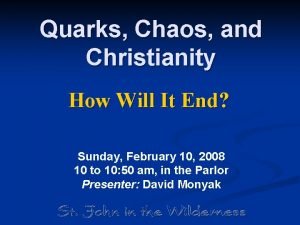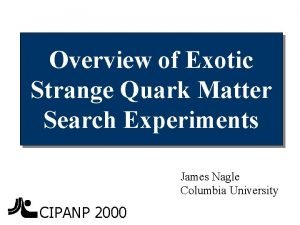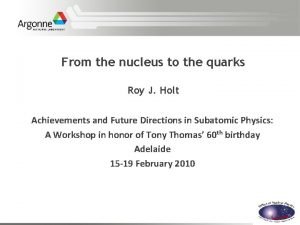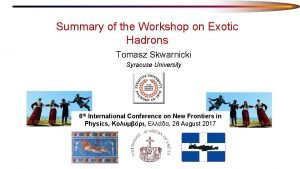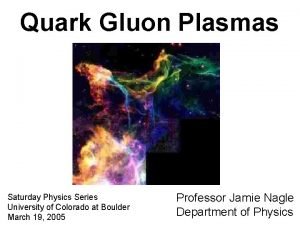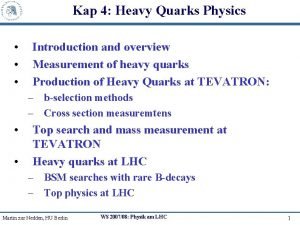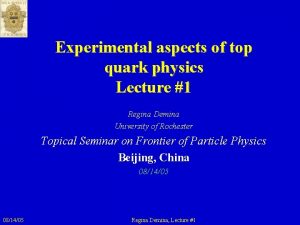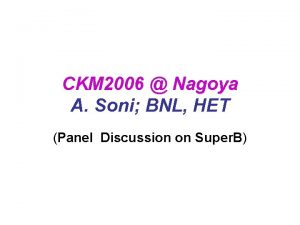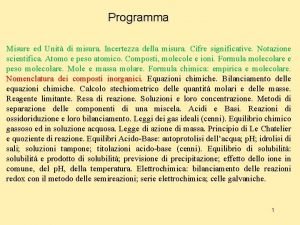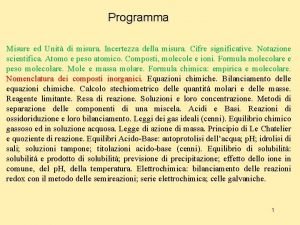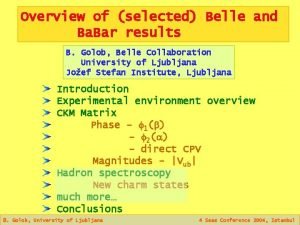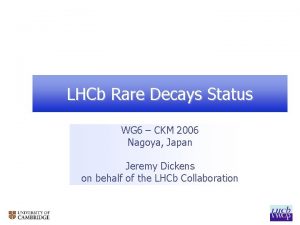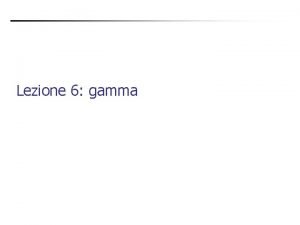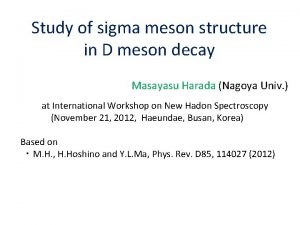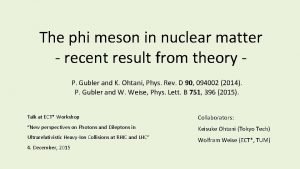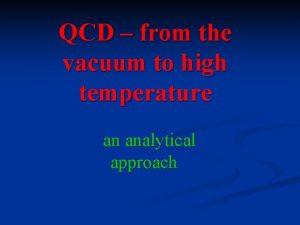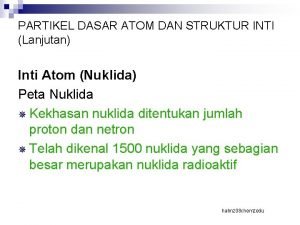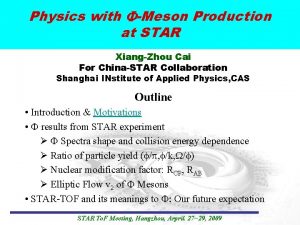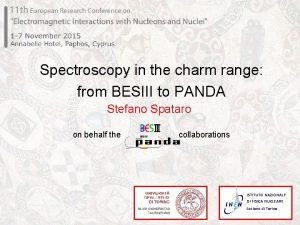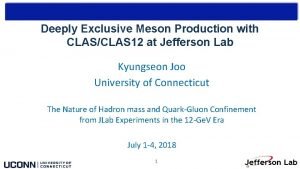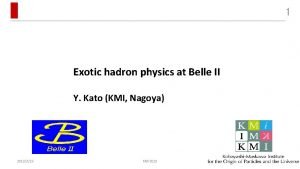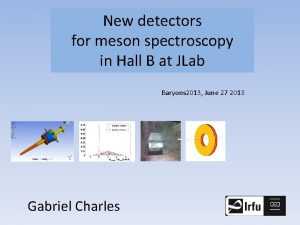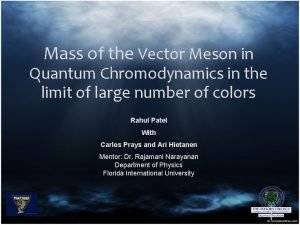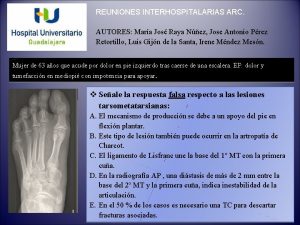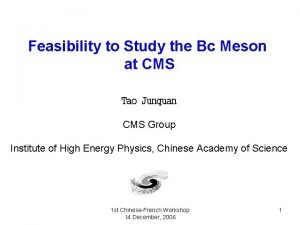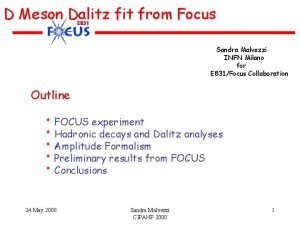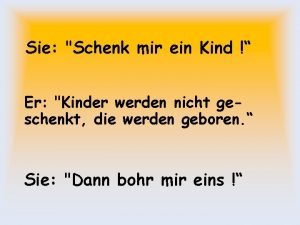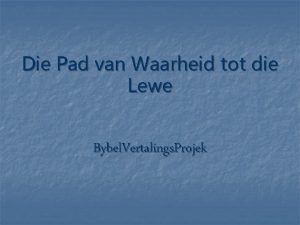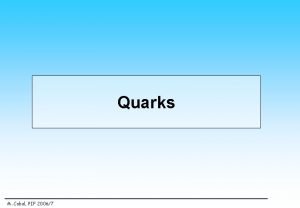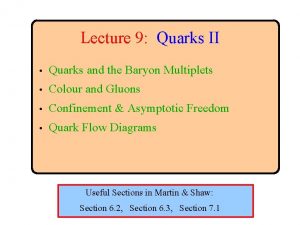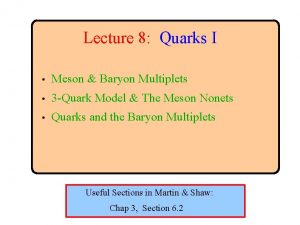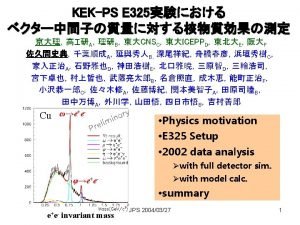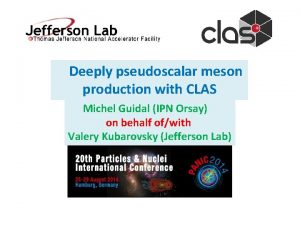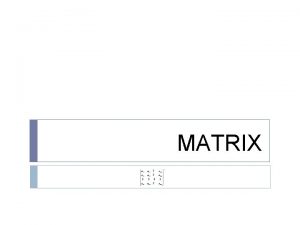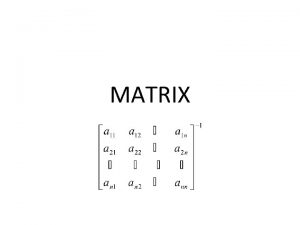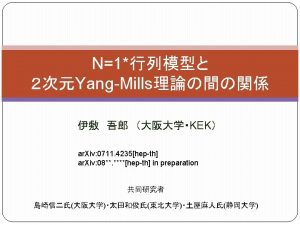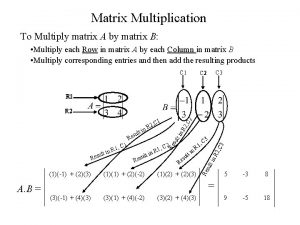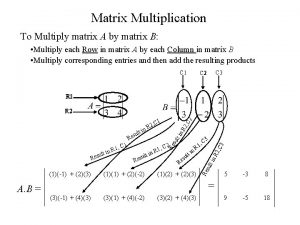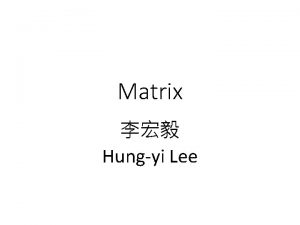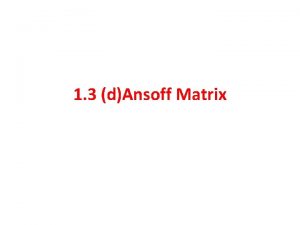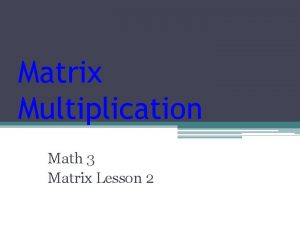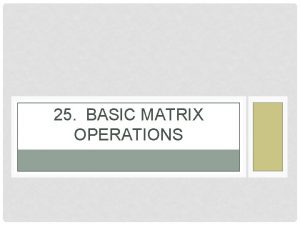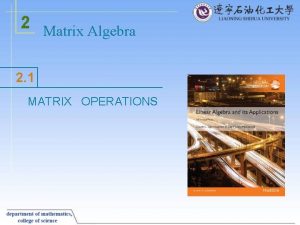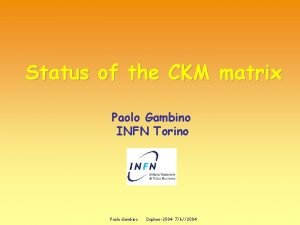IX Die FlavorPhysik der Quarks CKM Matrix Meson






























![The Ba. Bar Detector Superconducting Coil (1. 5 T) Silicon Vertex Tracker (SVT)[5 layers] The Ba. Bar Detector Superconducting Coil (1. 5 T) Silicon Vertex Tracker (SVT)[5 layers]](https://slidetodoc.com/presentation_image_h/22cb6efffcd043cf5001afc104b72e69/image-31.jpg)













- Slides: 44

IX. Die Flavor-Physik der Quarks: CKM Matrix, Meson Oszillationen, CP Verletzung Ergänzte Auszüge aus: Gerhard Raven Vrije Universiteit Amsterdam & NIKHEF Gerhard Raven, BND 2003 23/24/25 2003 Sommerschule BND’ 03 September 1

IX. 1. Neutral Kaon Mixing and Oscillation Phys. Rev. 97, 1387 (1955) September 23 -25, 2003 Known: 1. K 0 can decay to p+p. In quark picture: us vs. us Hypothesized: 1. K 0 has a distinct anti-particle K 0 Claims: 1. K 0 (K 0) is a “particle mixture” with two distinct lifetimes 2. Each lifetime has its own set of decay modes Gerhard BND 2 3. No more than. Raven, 50% of 2003 K 0 (K 0) will decay to p+p-

K 0 decay and CP: K 1 and K 2 are their own antiparticle, but one is CP even, the other CP odd: CP: +1 - + Phys Rev 103, 1901 (1956) Only the CP even state (K 1) can decay into 2 pions (which are CP even) The odd K 2 state will decay into 3 particles instead (ppp, pmn, pen, …). -1 There is a HUGE difference between K 0 pp and K 0 ppp in phasespace (~600 x!). So the CP even state will decay much faster The huge difference is because m. K 0 – 3 mp = 75 Me. V/c 2 September 23 -25, 2003 Gerhard Raven, BND 2003 3

More on time evolution K 1 decays K 2 decays Tag K 0 and K 0 decay by semileptonic decay September 23 -25, 2003 Gerhard Raven, BND 2003 4

Summary of neutral meson mixing B 0 meson Bs meson Blue line: given a P 0, at t=0, the probability of finding a P 0 at t. Red Line: given a P 0, at t=0, the probability of finding a P 0 bar at t. K 0 meson D 0 meson Q: why is D 0 meson mixing hardest to observe? Q: do you expect any other mesons to mix? September 23 -25, 2003 Gerhard Raven, BND 2003 5

IX. 2. CP Violation in K 0 Mixing September 23 -25, 2003 Gerhard Raven, BND 2003 6

Testing CP conservation Easy to create a pure K 2 beam: just “wait” until the K 1 component has decayed… If CP conserved, should not see the decay to 2 pions in this K 2 beam This is exactely what was tested by Cronin & Fitch in 1957… K 2 p+p. Effect is tiny: about 2/1000 q Main background: p+p- p 0 … and for this experiment they got the Nobel price in 1980… September 23 -25, 2003 Gerhard Raven, BND 2003 7

Discovery of CP violation in K 0 decay • In 1964, Cronin, Fitch et al. observed the long lived KL (which was presumed to be CP-odd) decaying into p+p-, which is a CP -even final state! – This decay occurs only ~0. 2% of the time • The long lived particle is therefore not a CP eigenstate, implying Weak Interaction violates CP • We now refer to the two different neutral kaons KL and KS as : K 1 and K 2 are the CP even and odd eigenstates, not KS and KL September 23 -25, 2003 Gerhard Raven, BND 2003 8

Interference between KS and KL: T-Violation! KL and KS are not orthogonal: + September 23 -25, 2003 Gerhard Raven, BND 2003 9

How to tell matter from anti-matter Tagged K 0 and K 0 production: CPLEAR, PLB 1999 K 0 KS like CPLEAR K 0 KS-KL interference KL like (K 0 -K 0)/(K 0+K 0) September 23 -25, 2003 Gerhard Raven, BND 2003 decaytime / t. KS 10

Escher on CP violation… P C CP C P September 23 -25, 2003 Gerhard Raven, BND 2003 11

IX. 3. Kobayashi, Maskawa and CP Violation #parameters: #rotations: #phases: Progress of Theoretical Physics 49, 652 (1973) Proposed an explanation of CP violation in KL decay: – CP violation appears only in the charged current weak interaction of quarks – There is a single source of CP Violation Complex Quantum Mechanical Phase in the coupling matrix – Need at least three Generations of Quarks to allow this • At that time only u, d, s known! • No generation structure known yet! – CP is not an approximate symmetry, large phase differences possible September 23 -25, 2003 Gerhard Raven, BND 2003 12

The weak coupling of quarks • The coupling strength at the vertex is given by g. Vij – g is the universal Fermi weak coupling – Vij depends on which quarks are W- b g. Vub u involved – For leptons, the coupling is just g • For 3 generations, the Vij can be written as a 3 x 3 matrix – This matrix is referred to as the CKM matrix (Cabibbo, Kobayashi, Maskawa) • We can view this matrix as rotating the quark states from a basis in which they are mass eigenstates to one in which they are weak eigenstates September 23 -25, 2003 Gerhard Raven, BND 2003 13

And now there is a subtle difference! CP W+ Wb g. V*ub g. Vub u September 23 -25, 2003 Gerhard Raven, BND 2003 14

CP Violation in the CKM Matrix 15

… and for anti-quarks 16

The Unitarity CKM Matrix: of the Unitarity CKM matrix Triangles = Complex phase λ =Vus = sin(q. Cabibbo) = 0. 227 ± 0. 001 A =Vcb/ λ 2 = 0. 83± 0. 06 d • s* = 0 (K system) s • b* = 0 (B system) d • b* = 0 (B system) • All triangles have the same area: Al 6 h • Out of 6 triangles, the “db*” one (together with the “tu*” one) is “special”: • It has all sides O(l 3) • And thus large angles September 23 -25, 2003 Measurements are usually summarized by plotting their constraints on the r-h plane Gerhard Raven, BND 2003 In the Wolfenstein parameterization, b=arg(Vtd), g=arg(Vub) 17

Unitarity Triangle: r, h from the sides Need to measure a, b and g, and check for consistency with the prediction from the magnitudes September 23 -25, 2003 Gerhard Raven, BND 2003 18

2002 A T L A S BABAR 1999 2008 BELLE CLEO 3 1999 2000 The Quest for CP Violation in the B System Mission Statement Obtain precision measurements in the domain of the charged weak interactions for testing the CKM sector of the Standard Model, and probing the origin of the CP violation phenomenon 19

IX. 4. CP violation in B 0 B 0 mixing CP violation can occur in the interference between the on-shell and off-shell amplitudes, and leads to Prob(B 0 B 0) Prob(B 0 B 0) |q/p| 1 However, for B 0 mesons, (unlike K 0 mesons), G 12 is very small: mixing is dominated by m=2 M 12 Do not expect much interference: need 2 amplitudes of comparable size Little chance of seeing CP violation in B 0 B 0 mixing… September 23 -25, 2003 Gerhard Raven, BND 2003 20

B 0 decay channels vs. K 0 decay channels b d g. Vcb s d g. Vus * W+ c d September 23 -25, 2003 * Only a tiny fractions of decays can be reached by both B 0 and B 0 bar; branching ratio CP eigenstates is very small! expect |G 12| to be negligible and thus | G| small and |q/p|=1 W+ u d This is completely different from the neutral kaon system: there all hadronic decays are CP eigenstates! expect |G 12| to be large, and thus | G| large and |q/p| 1 Gerhard Raven, BND 2003 21

Measurement of arg(Vtd) 22

23

B Meson Production: the “easy” way… • Electron-Positron collider: e+e- (4 s) B 0 B 0 BB threshold – Only 4 s resonance can produce B meson pair – Low B 0 production cross-section: ~1 nb – Clean environment, coherent B 0 B 0 production B-Factory approach CESR CLEO B 0 B 0 threshold September 23 -25, 2003 Gerhard Raven, BND 2003 24

(4 S): Coherent B 0 B 0 production • B 0 B 0 system produced by (4 S) decay evolves coherently until one of them decays (EPR!) – Instead of tagging the flavour at production, the B mesons have opposite flavour at the time the first B meson decays, so one tags the flavour of the other B decay at t=0: t t = t. CP - t. Other. B – Half of the time CP B decays first ( t<0) • Time integrated CP asymmetry is 0: + - At tcp=0 B 0 t(ps) At t=0 B 0 + - • Coherent production requires time dependent analysis September 23 -25, 2003 Incoherent Gerhard Raven, BND 2003 Coherent t(ps) 25

Time dependent asymmetry Shopping List: 1. Produce lots of B mesons 2. Reconstruct & select J/y. KS candidates 3. Tag production flavour 4. Determine the proper time t 5. Determine sin(2 b) from the observed asymmetry, taking into account the effects due to 1. finite time resolution 2. mistag rate September 23 -25, 2003 Gerhard Raven, BND 2003 26

A Symmetric Collider @ (4 S) won’t work… • CP asymmetry is a time-dependent process – ACP t between two B decays, t ~ ps – In reality one measures decay distance between two B decays • In symmetric energy e+e- collider, where (4 S) produced at rest, daughter B’s travel ~ 20 mm – Too small a distance to discern with today’s detector technology e+ Btag BCP 5. 3 Ge. V Sl 40 mm September 23 -25, 2003 Gerhard Raven, BND 2003 27

Coherent Time Evolution at the (4 S) PEP-2 (SLAC) B-Flavor Tagging Exclusive B Meson Reconstruction Vertexing & Time Difference Determination September 23 -25, 2003 Gerhard Raven, BND 2003 28

PEP-II: Asymmetric B Factory @ SLAC HER Linac HER LER Energy (Ge. V) 9. 0 3. 1 Number of bunches 1658 Beam Current (A) 1. 5 2. 5 Peak L ( 1033 cm-2 s-1 or nb-1/s) September 23 -25, 2003 bg = 0. 56, s = M (4 S) Collisions every 4. 2 ns. . fortunately most collisions don’t result in an interaction 7 Gerhard Raven, BND 2003 29

September 23 -25, 2003 Gerhard Raven, BND 2003 30
![The Ba Bar Detector Superconducting Coil 1 5 T Silicon Vertex Tracker SVT5 layers The Ba. Bar Detector Superconducting Coil (1. 5 T) Silicon Vertex Tracker (SVT)[5 layers]](https://slidetodoc.com/presentation_image_h/22cb6efffcd043cf5001afc104b72e69/image-31.jpg)
The Ba. Bar Detector Superconducting Coil (1. 5 T) Silicon Vertex Tracker (SVT)[5 layers] e+ (3 Ge. V) Drift Chamber [40 stereo lyrs](DCH) e- (9 Ge. V) Cs. I(Tl) Calorimeter (EMC) [6580 crystals]. Instrumented Flux Return (IFR) Cherenkov Detector (DIRC) [Iron interleaved with RPCs]. [144 quartz bars, 11000 PMTs] September 23 -25, 2003 Gerhard Raven, BND 2003 31

The Roadmap to sin 2 b z Flavour Tagging e+ K- Tag Vertex Reconstruction Exclusive B Meson Selection and Vertex Reconstruction Ingredient a) Higher precision b) Reconstruction of B mesons in flavour eigenstates Tag B vertex reconstruction • B 0 -Mixing c) Flavour Tagging (+ a + b) • CP-Asymmetries d) Reconstruction of B mesons in CP eigenstates (+ a + b + c) • sin(2 b) September 23 -25, 2003 Gerhard Raven, BND 2003 Increasing complexity • Measurements B±/B 0 Lifetimes 32

Dt Spectrum of CP events perfect flavour tagging & time resolution realistic mis-tagging & finite time resolution CP PDF Mistag fractions w And Resolution function R measured from fully reco’d flavour sample, B 0 -> D(*)+ p-, … (~10 x more events) September 23 -25, 2003 Mixing PDF Gerhard Raven, BND 2003 33

Blind Analysis All Ba. Bar analysis are done “blind” to eliminate possible experimenters’ bias –In general, measurements of a quantity “X” are done with likelihood fits – blinding done by replacing “X” with “X+R” in likelihood fits –R is draw from a Gaussian with a width a several times the expected error –Random number sequence is “seeded” with a “blinding string” –The reported statistical error is unaffected –It allows all systematic studies to be done while still blind –Example: the Ba. Bar sin(2 b) result for ICHEP 02 was “unblinded” 2 weeks before paper was submitted to hepex/PRL! September 23 -25, 2003 Gerhard Raven, BND 2003 34

September 23 -25, 2003 Gerhard Raven, BND 2003 35

“Golden” and J/y. KL Ba. Bar sin 2 b = 0. 755 0. 074 sin 2 b = 0. 723 0. 158 sin 2 b = 0. 741 0. 067 (stat) 0. 033 (syst) September 23 -25, 2003 Gerhard Raven, BND 2003 36

Compilation of sin 2 b Measurements World average ~13 s significant 0. 733± 0. 057 ± 0. 028 CP is broken in B decays sin 2 b = 0. 74 0. 05 0. 736 ± 0. 049 September 23 -25, 2003 Gerhard Raven, BND 2003 CP asymmetry in B J/y KS, L is large 37

Interpretation of the Result Method as in Höcker et al, hepex/0104062 (see also many other recent global CKM analyses) One solution for b is consistent with measurements of sides of the unitarity triangle Without using sin(2 b) Error on sin 2 b is still dominated by statistics and will decrease ~1/ for the forseeable future… The KM mechanism has successfully survived its first precision test! September 23 -25, 2003 Gerhard Raven, BND 2003 38

IX. But 5. But there penguins on the horizon! there areare penguins on the horizon! September 23 -25, 2003 Gerhard Raven, BND 2003 39

Penguin diagrams Nucl. Phys. B 131: 285 1977 Don’t try to beat Melissa Franklin at darts… September 23 -25, 2003 Gerhard Raven, BND 2003 40

Are The we sure that effect of A(J/psi penguins. KS) on = J/sin(2 b)? ? y KS Leading penguin contribution has same weak phase as tree èExtraction of sin(2 b) from J/y. KS is “theoretically clean” September 23 -25, 2003 Gerhard Raven, BND 2003 41

B 0 Kp and pp: towards a and g Tree diagrams s Penguin diagrams s K+ K+ Penguin dominated: B 0 p- p- d d p+ p+ B 0 September 23 -25, 2003 p- Potential direct CPV and constraints on g |Penguin| ~ 0. 3|Tree| p- Gerhard Raven, BND 2003 Complicates extraction of a from mixing induced CPV 42

Genug für heute… 43

… und genug von Pinguinen 44
 Die sprinkaan en die mier
Die sprinkaan en die mier Der daumen pflückt die pflaumen
Der daumen pflückt die pflaumen 6 types of quarks
6 types of quarks Quarks for dummies
Quarks for dummies 6 types of quarks
6 types of quarks Große stärke die man kleinsten teilchen entlockt
Große stärke die man kleinsten teilchen entlockt Gesichtsblindheit selbsttest
Gesichtsblindheit selbsttest Quarks chaos and christianity
Quarks chaos and christianity Color quarks
Color quarks Quarks
Quarks Color quarks
Color quarks Proton neutron quarks
Proton neutron quarks Quarks
Quarks Proton neutron quarks
Proton neutron quarks Quarks regina
Quarks regina Het panel
Het panel Matrice ckm
Matrice ckm Pronhub.ckm
Pronhub.ckm Manganato.ckm
Manganato.ckm Catione monoatomico
Catione monoatomico Dsp0m
Dsp0m Ckm 2006
Ckm 2006 Matrice ckm
Matrice ckm Parler.ckm
Parler.ckm Sigma meson
Sigma meson Phi meson
Phi meson Meson valves
Meson valves Partikel meson
Partikel meson Lucas 10 30 37
Lucas 10 30 37 K star meson
K star meson Ombesito
Ombesito Jefferson lab
Jefferson lab B meson decay
B meson decay Meson
Meson Meson
Meson Irene mendez meson
Irene mendez meson Mumu+
Mumu+ Meson la fit
Meson la fit Die kinder verbringen die ferien
Die kinder verbringen die ferien Je höher die berge desto schöner die gams
Je höher die berge desto schöner die gams Kort termyn doelwitte
Kort termyn doelwitte Die hippies die
Die hippies die Die einde van die koue oorlog 1989
Die einde van die koue oorlog 1989 Ek glo in god die vader die almagtige
Ek glo in god die vader die almagtige Die pad van waarheid tot die lewe
Die pad van waarheid tot die lewe
